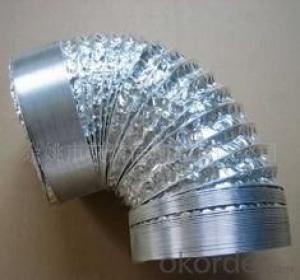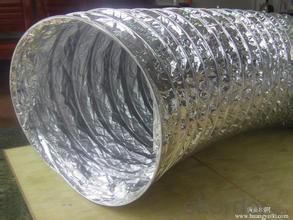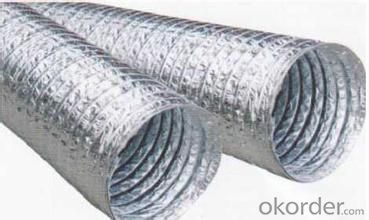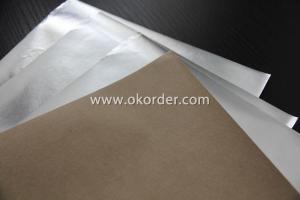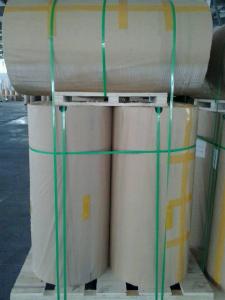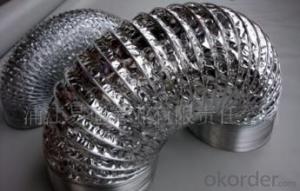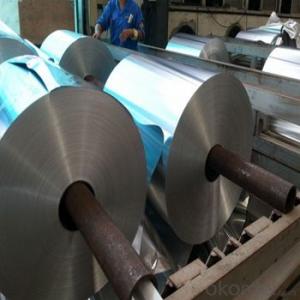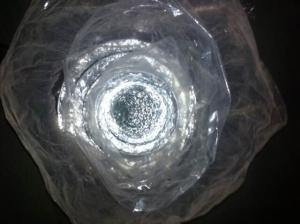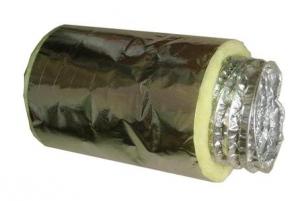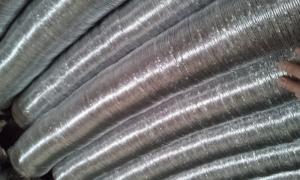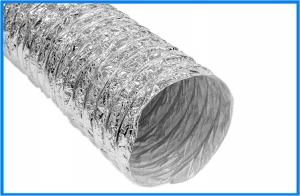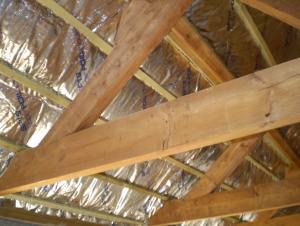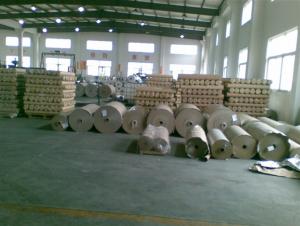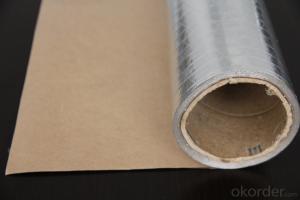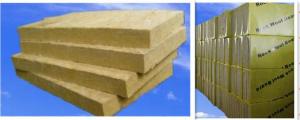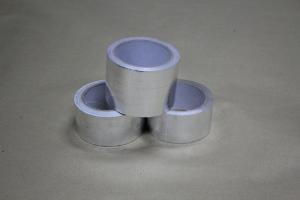Aluminum Foil Facing Uninsulated Insulated Flexible Ducts in Very High Quality
- Loading Port:
- Shanghai
- Payment Terms:
- TT or LC
- Min Order Qty:
- 500 pc
- Supply Capability:
- 50000 pc/month
OKorder Service Pledge
OKorder Financial Service
You Might Also Like
Features and Characters:
-Applied in Heating, Ventilation and Air Conditioning
-Non-insulated and insulated Flexible Duct offered
-Up to 150℃ and 250℃ high temperature
-Fire Retardant
-Corrosion Resistant
-High flexibility
-Convenient installation
-Non- toxic
Introduction
Flexible Duct is widely used in Heating, Ventilation and Air Conditioning (HVAC) systems for air ventilation applications. Flexible Duct provides greater thermal efficiency to save energy. The product is also covered in a heavy duty, silver jacket for durability. The vapor barrier prevents condensation forming on the outside of ducts carrying air. Because it is flexible, it is easy to run around and through obstacles in the building.
Non-insulated Flexible Duct
Structure: Two-layer aluminum foils +1 layer of PET film.
Non-insulated Flexible Duct | |
Diameter | 80-1200mm(3''-48'') |
Temperature Range | -30℃~ +250℃ |
Velocity of Airflow (Max.) | 30m/s |
Working Pressure | 2500/Pa |
Bending Radius | 0.54*D |
Fire-retardant Grade | S1 |
Standard Length | 10m or 7.6m |
Non-insulated Flexible Duct | |
Diameter | 80-1200mm(3''-48'') |
Temperature Range | -30℃~ +150℃ |
Velocity of Airflow(Max.) | 30m/s |
Working Pressure | 2500/Pa |
Bending Radius | 0.54*D |
Fire-retardant Grade | S1 |
Standard Length | 10m or 7.6m |
Insulated Flexible Duct
Structure: 1 layer of Alu. Foil+1 layer PET film+ glass wool
Outer jacket: 1 layer of Alu.foil
Glass Wool Density: 16kg/m3; Thickness: 25mm
Insulated Flexible Duct | |
Diameter | 80-1200mm(3''-48'') |
Temperature Range | -30℃~ +250℃ |
Velocity of Airflow(Max.) | 30m/s |
Working Pressure | 2500/Pa |
Bending Radius | 0.54*D |
Fire-retardant Grade | S1 |
Standard Length | 10m or 7.6m |
Insulated Flexible Duct | |
Diameter | 80-1200mm(3''-48'') |
Temperature Range | -30℃~ +150℃ |
Velocity of Airflow(Max.) | 30m/s |
Working Pressure | 2500/Pa |
Bending Radius | 0.54*D |
Fire-retardant Grade | S1 |
Standard Length | 10m or 7.6m |
- Q: This question is asking for instructions on how to clean and store aluminum foil rolling film to maintain its quality and usability.
- <p>To clean aluminum foil rolling film, gently wipe it with a damp cloth to remove any residue. Avoid using abrasive materials that could scratch the surface. After cleaning, let it dry completely. To store, roll the film tightly and wrap it in a protective layer, such as a plastic wrap or a clean cloth, to prevent dust and scratches. Store it in a cool, dry place away from direct sunlight to maintain its integrity.</p>
- Q: What are the advantages of using recycled aluminum foil for cooking and food storage?
- <p>Using recycled aluminum foil in cooking and food storage offers several benefits. It is environmentally friendly as it reduces waste and conserves resources. Recycled foil retains the same properties as non-recycled foil, providing excellent heat conduction and insulation, which is crucial for even cooking and maintaining food temperature. It is also cost-effective as it is generally cheaper than non-recycled foil. Moreover, it is versatile, suitable for a wide range of applications from baking to wrapping food for storage. However, it's important to ensure that the recycled foil is food-grade and meets safety standards to avoid any health risks.</p>
- Q: Is it possible to use aluminum foil with a facing layer to create a pie crust or tart crust?
- <p>Using aluminum foil facing to make a pie crust or tart crust is not recommended. Aluminum foil is not designed for baking and can react with acidic foods, potentially releasing harmful substances. Additionally, it won't provide the same texture or structure as a traditional pie crust. Instead, use materials specifically designed for baking, such as pie dough, tart shells, or parchment paper, which are safe and designed to withstand high temperatures without compromising the taste or quality of your baked goods.</p>
- Q: What are the materials and elements that make up the aluminum foil facing?
- <p>Aluminum foil facing is primarily composed of aluminum, which is a lightweight, malleable, and ductile metal with the symbol Al and atomic number 13. It is commonly used in construction, packaging, and cooking due to its excellent thermal and electrical conductivity, as well as its resistance to corrosion. The aluminum used for foil is typically of high purity, but it may also contain trace amounts of other elements to enhance certain properties, such as copper to improve strength or magnesium to increase resistance to corrosion. The facing can also have a protective layer or coating to prevent oxidation or to enhance its performance in specific applications.</p>
- Q: This question asks for a comparison between aluminum foil facing and other types of metal foils, highlighting their differences.
- <p>Aluminum foil facing is distinct from other metal foils due to its specific properties. It is lightweight, highly reflective, and offers excellent heat conductivity, making it ideal for insulation and cooking applications. Unlike other metal foils, aluminum foil is non-toxic and can be safely used in food packaging and preparation. It is also corrosion-resistant and has a lower melting point compared to metals like steel or copper, which affects its usability in various industries. Additionally, aluminum foil is more affordable and widely available than some other metal foils, contributing to its popularity in everyday use.</p>
- Q: What are the various materials used as facings for aluminum foil, and how do they differ from one another?
- <p>Aluminum foil facing materials are used in construction and insulation to provide a barrier against air and moisture. The different types include: 1) Kraft paper facing, which is a strong, absorbent paper used for general purposes; 2) Glassine facing, a thin, glossy paper with good water resistance; 3) PE-coated facing, where a layer of polyethylene is applied for enhanced water resistance; 4) Aluminum foil facing, which is a thin layer of aluminum for superior barrier properties; 5) Silicone-treated glass fabric, offering high-temperature resistance and used in high-performance applications. Each type has unique properties affecting their use in various applications.</p>
- Q: This question asks for methods to clean oil stains from the aluminum foil facing of a surface.
- <p>To remove oil stains from aluminum foil facing, start by scraping off any excess oil with a plastic scraper or a butter knife. Then, mix a solution of warm water and dish soap. Apply the solution to the stained area and let it sit for a few minutes. Use a soft cloth or sponge to gently scrub the area. Rinse with warm water and dry thoroughly. For stubborn stains, you can use a mixture of baking soda and water to create a paste, apply it to the stain, let it sit for 15 minutes, then scrub and rinse. Always test cleaning methods on a small, inconspicuous area first to ensure no damage occurs.</p>
- Q: This question asks for a comparison of the pros and cons of using aluminum foil as a facing material in food packaging.
- <p>Aluminum foil facing in food packaging offers several advantages, such as excellent barrier properties against light, oxygen, and moisture, which helps in preserving the freshness and taste of food. It is also lightweight, cost-effective, and provides a shiny, visually appealing appearance. Additionally, aluminum foil is recyclable, contributing to sustainability efforts. However, there are disadvantages, including its limited heat resistance, which can lead to warping or melting when exposed to high temperatures. It can also cause environmental concerns due to improper disposal, as it is not biodegradable and can contribute to littering if not recycled properly.</p>
- Q: Is it safe to use aluminum foil facing inside a microwave oven?
- <p>No, it is not safe to use aluminum foil facing in the microwave oven. Aluminum foil can cause sparks and potentially start a fire due to the reflective nature of the metal. It can also damage the oven's interior. Always use microwave-safe materials and avoid metal when cooking in a microwave.</p>
- Q: This question asks for a list of various types of aluminum foil facing that can be found in the market.
- <p>There are several types of aluminum foil facing available in the market today, including: 1. Standard Aluminum Foil Facing, which is the most common type used for insulation and moisture protection. 2. Reinforced Aluminum Foil Facing, which is stronger and more durable, often used in high-temperature applications. 3. Embossed Aluminum Foil Facing, which has a textured surface for improved aesthetics and grip. 4. Coated Aluminum Foil Facing, which is coated with materials like polyethylene for added protection against chemicals or moisture. 5. Perforated Aluminum Foil Facing, which has small holes for ventilation or drainage. 6. Laminated Aluminum Foil Facing, which combines aluminum with other materials for enhanced properties. These types cater to various applications in construction, food packaging, and other industries.</p>
Send your message to us
Aluminum Foil Facing Uninsulated Insulated Flexible Ducts in Very High Quality
- Loading Port:
- Shanghai
- Payment Terms:
- TT or LC
- Min Order Qty:
- 500 pc
- Supply Capability:
- 50000 pc/month
OKorder Service Pledge
OKorder Financial Service
Similar products
Hot products
Hot Searches
Related keywords

